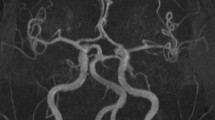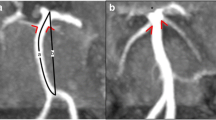Abstract
Background and objectives
Pompe disease is a rare metabolic disorder due to lysosomal alpha-glucosidase (GAA) deficiency. It is considered as a multi-systemic disease since, although glycogen accumulation is largely prominent in heart, skeletal and respiratory muscles, other organs can also be affected. As regards the vascular system, few reports have documented cerebrovascular malformations in Pompe patients. The aim of this study was to define the presence and type of intracranial arterial abnormalities in a cohort of late onset Pompe disease (LOPD) patients.
Methods
We have studied 21 LOPD patients with cerebral CT angiography (CTA), using maximum intensity projection and volume rendering technique for 3D-image reconstruction.
Results
We found intracranial arterial abnormalities in 13/21 patients (62 %), of whom: 2/21 patients (9.5 %) showed an unruptured intracranial aneurysm (respectively 2 and 4 mm), 10/21 (47 %) had a vertebrobasilar dolichoectasia (VBD) and 1/21 a basilar artery fenestration. Signs of lacunar encephalopathy (insular, capsular and frontal subcortical lesions) were detected in 13/21 patients (62 %) and this correlated with the presence of respiratory impairment (p = 0.017).
Conclusions
These findings differ from what has been previously observed in healthy, aged-matched populations and confirm that cerebral arteries abnormalities, mainly involving the posterior circle, are not so rare in LOPD patients and are often accompanied by a lacunar encephalopathy that might represent a hypoxic-ischemic origin. A CTA or an MRA is recommended, in LOPD patients, for early detection of cerebrovascular malformations as they could lead to life-threatening events such as sub-arachnoid haemorrhage or brainstem compression.


Similar content being viewed by others
References
Anneser JM, Pongratz DE, Podskarbi T, Shin YS, Schoser BG (2005) Mutations in the acid alpha-glucosidase gene (M. Pompe) in a patient with an unusual phenotype. Neurology 64:368–70
Bertoldo F, Zappini F, Brigo M et al (2015) Prevalence of asymptomatic vertebral fractures in late-onset Pompe disease. J Clin Endocrinol Metab 100:401–6
Brown RD, Broderick JP (2014) Unrupted intracranial aneurysms: epidemiology, natural history, management options, and familial screening. Lancet Neurol 13:393–404
DeRuisseau LR, Fuller DD, Qiu K et al (2009) Neural deficits contribute to respiratory insufficiency in Pompe disease. Proc Natl Acad Sci U S A 106:9419–24
Förster A, Ssozi J, Al-Zghloul M, Brockmann MA, Kerl HU, Groden C (2014) A comparison of CT/CT angiography and MRI/MR angiography for imaging of vertebrobasilar dolichoectasia. Clin Neuroradiol 24(4):347–53
Gaeta M, Barca E, Ruggeri P et al (2013) A late-onset Pompe disease (LOPD): correlations between respiratory muscles CT and MRI features and pulmonary function. Mol Genet Metab 110:290–6
Gutierrez J, Bagci A, Gardener H et al (2014) Dolichoectasia diagnostic methods in a multi-ethnic, stroke-free cohort: results from the Northern Manhattan Study. J Neuroimaging 24:226–31
Hensel O, Hanisch F, Stock K et al (2015) Morphology and function of cerebral arteries in adults with pompe. Dis JIMD Rep 20:27–33
Hobson-Webb LD, Proia AD, Thurberg BL et al (2012) Autopsy findings in late-onset Pompe disease: a case report and systematic review of the literature. Mol Genet Metab 106:462–9
Kanters TA, Hoogenboom-Plug I, Rutten-Van Mölken MP et al (2014) Cost-effectiveness of enzyme replacement therapy with alglucosidase alfa in classic-infantile patients with Pompe disease. Orphanet J Rare Dis 9:75
Kapsalaki EZ, Rountas CD, Fountas KN (2012) The role of 3 tesla MRA in the detection of intracranial aneurysms. Int J Vasc Med 2012:792–834
Karabul N, Skudlarek A, Berndt J, Kornblum C, Kley RA, Wenninger S, Tiling N, Mengel E, Plöckinger U, Vorgerd M, Deschauer M, Schoser B, Hanisch F (2014) Urge incontinence and gastrointestinal symptoms in adult patients with pompe disease: a cross-sectionalsurvey. JIMD Rep 17:53–61
Komotar RJ, Mocco J, Solomon RA (2008) Guidelines for the surgical treatment of unruptured intracranial aneurysms: the first annual J. Lawrence pool memorial research symposium—controversies in the management of cerebral aneurysms. Neurosurgery 62:183–93, discussion 193–4
Kretzschmar HA, Wagner H, Hübner G et al (1990) Aneurysms and vacuolar degeneration of cerebral arteries in late-onset acid maltase deficiency. J Neurol Sci 98:169–83
Kumral E, Kisabay A, Ataç C et al (2005) The mechanism of ischemic stroke in patients with dolichoectatic basilar artery. Eur J Neurol 12:437–44
Laforêt P, Petiot P, Nicolino M et al (2008) Dilative arteriopathy and basilar artery dolichoectasia complicating late-onset Pompe disease. Neurology 70(22):2063–6
Laforêt P, Laloui K, Granger B, The French Pompe registry et al (2013) Baseline characteristics of a cohort of 126 patients with adult Pompe disease. Rev Neurol (Paris) 169(8–9):595–602
Lim JA, Li L, Raben N (2014) Pompe disease: from pathophysiology to therapy and back again. Front Aging Neurosci 6:177
Mellies U, Lofaso F (2009) Pompe disease: a neuromuscular disease with respiratory muscle involvement. Respir Med 103:477–84
Montagnese F, Barca E, Musumeci O et al (2015) Clinical and molecular aspects of 30 patients with late-onset Pompe disease (LOPD): unusual features and response to treatment. J Neurol 262:968–78
Musumeci O, Catalano N, Barca E et al (2012) Auditory system involvement in late onset Pompe disease: a study of 20 Italian patients. Mol Genet Metab 107:480–4
Passero SG, Rossi S (2008) Natural history of vertebrobasilar dolichoectasia. Neurology 70:66–72
Pizza F, Biallas M, Wolf M et al (2010) Nocturnal cerebral hemodynamics in snorers and in patients with obstructive sleep apnea: a near-infrared spectroscopy study. Sleep 33:205–10
Remiche G, Herbaut AG, Ronchi D et al (2012) Incontinence in late-onset Pompe disease: an underdiagnosed treatable condition. Eur Neurol 68:75–8
Sacconi S, Bocquet JD, Chanalet S, Tanant V, Salviati L (2010) Desnuelle C abnormalities of cerebral arteries are frequent in patients with late-onset Pompe disease. J Neurol 257:1730–3
Schüller A, Wenninger S, Strigl-Pill N et al (2012) Toward deconstructing the phenotype of late-onset Pompe disease. Am J Med Genet C Semin Med Genet 160C:80–8
Sogawa K, Kikuchi Y, O’uchi T et al (2013) Fenestrations of the basilar artery demonstrated on magnetic resonance angiograms: an analysis of 212 cases. Interv Neuroradiol 19:461–5
Tanaka M, Sakaguchi M, Miwa K et al (2013) Basilar artery diameter is an independent predictor of incident cardiovascular events. Arterioscler Thromb Vasc Biol 33:2240–4
Toscano A, Schoser B (2013) Enzyme replacement therapy in late-onset Pompe disease: a systematic literature review. J Neurol 260:951–9
Vlak MH, Algra A, Branderburg R et al (2011) Prevalence of unrupted intracranial aneurysms, with emphasis on sex, age, comorbidity, country, and time period: a systematic review and meta-analysis. Lancet Neurol 10:595–7
Wiebers DO (2006) Unruptured intracranial aneurysms: natural history and clinical management. Update on the international study of unruptured intracranial aneurysms. Neuroimaging Clin N Am 16:383–390
Yuan YJ, Xu K, Yu J (2014) Research progress on vertebrobasilar dolichoectasia. Int J Med Sci 11:1039–1048
Author information
Authors and Affiliations
Corresponding author
Ethics declarations
Conflict of interest
Antonio Toscano received from Genzyme-Sanofi grants and reimbursements for teaching courses and participation to meetings of Global Advisory Board for Pompe Disease. Federica Montagnese, Francesca Granata, Olimpia Musumeci, Carmelo Rodolico, Stefania Mondello, Emanuele Barca, Maria Cucinotta, Anna Ciranni and Marcello Longo declare that they have no conflict of interests.
Informed consent
All followed procedures were in accordance with the ethical standards of the responsible committee on human experimentation (institutional and national) and with the Helsinki Declaration of 1975, as revised in 2000. Informed consent was obtained from all patients for being included in the study.
Details of the contributions of individual authors
All the authors have contributed to the present work either in its conception and design or in the analysis and interpretation of the data.
Additional information
Communicated by: Greg Enns
Rights and permissions
About this article
Cite this article
Montagnese, F., Granata, F., Musumeci, O. et al. Intracranial arterial abnormalities in patients with late onset Pompe disease (LOPD). J Inherit Metab Dis 39, 391–398 (2016). https://doi.org/10.1007/s10545-015-9913-x
Received:
Revised:
Accepted:
Published:
Issue Date:
DOI: https://doi.org/10.1007/s10545-015-9913-x




